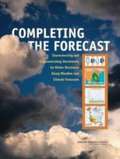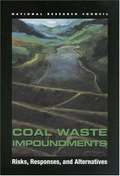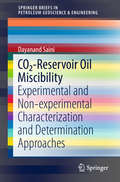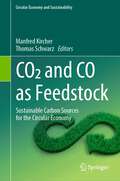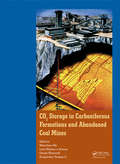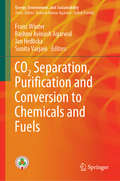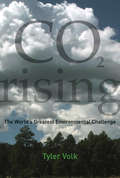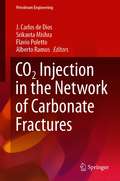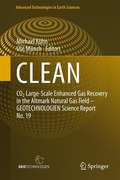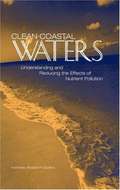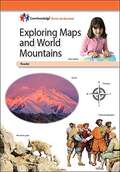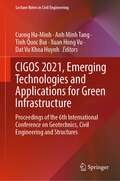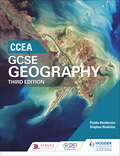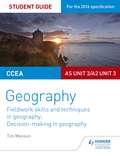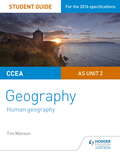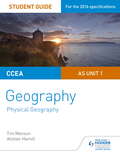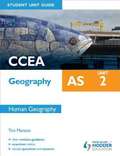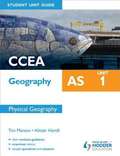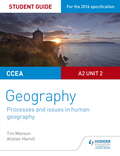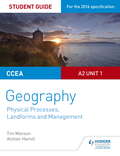- Table View
- List View
COMPLETING THE FORECAST: Characterizing and Communicating Uncertainty for Better Decisions Using Weather and Climate Forecasts
by National Research Council of the National AcademiesUncertainty is a fundamental characteristic of weather, seasonal climate, and hydrological prediction, and no forecast is complete without a description of its uncertainty. Effective communication of uncertainty helps people better understand the likelihood of a particular event and improves their ability to make decisions based on the forecast. Nonetheless, for decades, users of these forecasts have been conditioned to receive incomplete information about uncertainty. They have become used to single-valued (deterministic) forecasts (e.g., "the high temperature will be 70 degrees Farenheit 9 days from now") and applied their own experience in determining how much confidence to place in the forecast. Most forecast products from the public and private sectors, including those from the National Oceanographic and Atmospheric Administration’s National Weather Service, continue this deterministic legacy. Fortunately, the National Weather Service and others in the prediction community have recognized the need to view uncertainty as a fundamental part of forecasts. By partnering with other segments of the community to understand user needs, generate relevant and rich informational products, and utilize effective communication vehicles, the National Weather Service can take a leading role in the transition to widespread, effective incorporation of uncertainty information into predictions. "Completing the Forecast" makes recommendations to the National Weather Service and the broader prediction community on how to make this transition.
COAL WASTE IMPOUNDMENTS: Risks, Responses, and Alternatives
by Committee on Coal Waste ImpoundmentsOn October 11, 2000, a breakthrough of Martin County Coal Corporation’s coal waste impoundment released 250 million gallons of slurry in near Inez, Kentucky. The 72-acre surface impoundment for coal processing waste materials broke through into a nearby underground coal mine. Although the spill caused no loss of human life, environmental damage was significant, and local water supplies were disrupted. This incident prompted Congress to request the National Research Council to examine ways to reduce the potential for similar accidents in the future. This book covers the engineering practices and standards for coal waste impoundments and ways to evaluate, improve, and monitor them; the accuracy of mine maps and ways to improve surveying and mapping of mines; and alternative technologies for coal slurry disposal and utilization. The book contains advice for multiple audiences, including the Mine Safety and Health Administration, the Office of Surface Mining, and other federal agencies; state and local policymakers and regulators; the coal industry and its consultants; and scientists and engineers.
CO2-Reservoir Oil Miscibility: Experimental and Non-experimental Characterization and Determination Approaches (SpringerBriefs in Petroleum Geoscience & Engineering)
by Dayanand SainiThis SpringerBrief critically examines the latest experimental and non-experimental approaches used for the fast and reliable characterization and determination of CO2-reservoir oil miscibility in terms of the minimum miscibility pressure (MMP). This book serves as a one-stop source for developing an enhanced understanding of these available methods, and specifically documents, analyses, and evaluates their suitability and robustness for depicting and characterizing the phenomenon of CO2-reservoir oil miscibility in a fast and cost-effective manner. Such information can greatly assist a project team in selecting an appropriate MMP determination method as per the project’s need at a given project’s stage, be that screening, design, or implementation. CO2-Reservoir Oil Miscibility: Experiential and Non-Experimental Characterization and Determination Approaches will be of interest to petroleum science and engineering professionals, researchers, and undergraduate and graduate students engaged in CO2 enhanced oil recovery (EOR) and/or simultaneous CO2-EOR and storage projects and related research. It may also be of interest to engineering and management professionals within the petroleum industry who have responsibility for implementing CO2-EOR projects.
CO2 and CO as Feedstock: Sustainable Carbon Sources for the Circular Economy (Circular Economy and Sustainability)
by Thomas Schwarz Manfred KircherClimate protection and raw material change require new, sustainable carbon sources for the chemical and fuel industries. In fact, processes that recycle carbon-containing emission and gas streams industrially are reaching industrial practice. They will make an important contribution to reducing carbon emissions and moving towards a true carbon circular economy. This book describes the basics of chemical and biotechnological processes for converting CO and CO2 into chemicals and fuels. Furthermore, it addresses potentials for the manufacturing economy, industrial sites and regions and answers the following questions. Which emission and gas streams offer feedstock potential? What processes are already implemented, being tested and under development?What products can be made from gaseous carbon sources?How can carbon emitting and consuming industries be linked into new value chains?What is the regulatory framework?What does the ecological footprint look like?How do the new processes contribute to the regional economy and thus to social acceptance among consumers and among decision-makers in companies and politics?Providing companies with sustainable carbon sources is a central question of the circular economy, which must be answered with technical processes, new cross-sector value chains, adapted infrastructure and further developed framework conditions. This concerns scientists and decision-makers in companies alike. In this book, they as well as interested laymen will find a comprehensive overview of the state of the art in both, technology and research, and of the overriding issues involved in establishing CO2 and CO as feedstocks.
CO2 Storage in Carboniferous Formations and Abandoned Coal Mines
by Manchao He Luis Ribeiro e Sousa Derek Elsworth Euripedes VargasUnderground geological storage of carbon dioxide (CO2) has considerable potential for mitigating climate change. CO2 can be safely injected and stored at well characterized and properly managed sites. Injecting carbon dioxide in deep geological formations can store it underground for long periods of time. Depleted oil and gas reservoirs, saline aqu
CO2 Separation, Purification and Conversion to Chemicals and Fuels
by Franz Winter Rashmi Avinash Agarwal Jan Hrdlicka Sunita VarjaniThis book presents the recent research on the separation, purification and downstream utilization of CO2 and other flue gases. Chapters include a detailed discussion on the purification and further conversion of CO2 to commodity chemicals and fuels. With contributions from renowned researchers in the field, the book focuses on the current challenges of catalytic high-pressure chemical conversion and biochemical conversion into high-value products. This book is of interest to researchers, professionals, and students working on carbon capture and sequestration, and is a valuable resource for policy makers and government agents working on guidelines and frameworks for carbon capture and reuse.
CO2 Rising: The World's Greatest Environmental Challenge (The\mit Press Ser.)
by Tyler VolkAn introduction to the global carbon cycle and the human-caused disturbances to it that are at the heart of global warming and climate change.The most colossal environmental disturbance in human history is under way. Ever-rising levels of the potent greenhouse gas carbon dioxide (CO2) are altering the cycles of matter and life and interfering with the Earth's natural cooling process. Melting Arctic ice and mountain glaciers are just the first relatively mild symptoms of what will result from this disruption of the planetary energy balance. In CO2 Rising, scientist Tyler Volk explains the process at the heart of global warming and climate change: the global carbon cycle. Vividly and concisely, Volk describes what happens when CO2 is released by the combustion of fossil fuels (coal, oil, and natural gas), letting loose carbon atoms once trapped deep underground into the interwoven web of air, water, and soil. To demonstrate how the carbon cycle works, Volk traces the paths that carbon atoms take during their global circuits. Showing us the carbon cycle from a carbon atom's viewpoint, he follows one carbon atom into a leaf of barley and then into an alcohol molecule in a glass of beer, through the human bloodstream, and then back into the air. He also compares the fluxes of carbon brought into the biosphere naturally against those created by the combustion of fossil fuels and explains why the latter are responsible for rising temperatures. Knowledge about the global carbon cycle and the huge disturbances that human activity produces in it will equip us to consider the hard questions that Volk raises in the second half of CO2 Rising: projections of future levels of CO2; which energy systems and processes (solar, wind, nuclear, carbon sequestration?) will power civilization in the future; the relationships among the wealth of nations, energy use, and CO2 emissions; and global equity in per capita emissions. Answering these questions will indeed be our greatest environmental challenge.
CO2 Injection in the Network of Carbonate Fractures (Petroleum Engineering)
by Alberto Ramos J. Carlos de Dios Srikanta Mishra Flavio PolettoThis book presents guidelines for the design, operation and monitoring of CO2 injection in fractured carbonates, with low permeability in the rock matrix, for geological storage in permanent trapping. CO2 migration is dominated by fractures in formations where the hydrodynamic and geochemical effects induced by the injection play a key role influencing the reservoir behavior. CO2 injection in these rocks shows specific characteristics that are different to injection in porous media, as the results from several research studies worldwide reveal. All aspects of a project of this type are discussed in this text, from the drilling to the injection, as well as support works like well logging, laboratory and field tests, modeling, and risk assessment. Examples are provided, lesson learned is detailed, and conclusions are drawn. This work is derived from the experience of international research teams and particularly from that gained during the design, construction and operation of Hontomín Technology Development Plant. Hontomín research pilot is currently the only active onshore injection site in the European Union, operated by Fundación Ciudad de la Energía-CIUDEN F.S.P. and recognized by the European Parliament as a key test facility. The authors provide guidelines and tools to enable readers to find solutions to their problems. The book covers activities relevant to a wide range of practitioners involved in reservoir exploration, modeling, site operation and monitoring. Fluid injection in fractured media shows specific features that are different than injection in porous media, influencing the reservoir behavior and defining conditions for safe and efficient operation. Therefore, this book is also useful to professionals working on oil & gas, hydrogeology and geothermal projects, and in general for those whose work is related to activities using fluid injection in the ground.
CLEAN: CO2 Large-Scale Enhanced Gas Recovery in the Altmark Natural Gas Field - GEOTECHNOLOGIEN Science Report No. 19 (Advanced Technologies in Earth Sciences)
by Ute Münch Michael KühnThe project CLEAN (CO2 Large-Scale Enhanced Gas Recovery in the Altmark Natural Gas Field) provides site specific knowledge for a potential future pilot project. This contributed volume gives an overview and final results of the entire project which is finalized to the end of 2012.
CLEAN COASTAL WATERS: Understanding and Reducing the Effects of Nutrient Pollution
by Committee on the Causes Management of Coastal EutrophicationEnvironmental problems in coastal ecosystems can sometimes be attributed to excess nutrients flowing from upstream watersheds into estuarine settings. This nutrient over-enrichment can result in toxic algal blooms, shellfish poisoning, coral reef destruction, and other harmful outcomes. All U.S. coasts show signs of nutrient over-enrichment, and scientists predict worsening problems in the years ahead.Clean Coastal Waters explains technical aspects of nutrient over-enrichment and proposes both immediate local action by coastal managers and a longer-term national strategy incorporating policy design, classification of affected sites, law and regulation, coordination, and communication.Highlighting the Gulf of Mexico's "Dead Zone," the Pfiesteria outbreak in a tributary of Chesapeake Bay, and other cases, the book explains how nutrients work in the environment, why nitrogen is important, how enrichment turns into over-enrichment, and why some environments are especially susceptible. Economic as well as ecological impacts are examined.In addressing abatement strategies, the committee discusses the importance of monitoring sites, developing useful models of over-enrichment, and setting water quality goals. The book also reviews voluntary programs, mandatory controls, tax incentives, and other policy options for reducing the flow of nutrients from agricultural operations and other sources.
CKHG - Core Knowledge History and Geography Exploring Maps and World Mountains
by Core Knowledge FoundationFrom the CORE KNOWLEDGE FOUNDATION, which brought you the popular “What Your ___ Grader Needs to Know” series. EXPLORING MAPS AND WORLD MOUNTAINS is divided into two parts. The first part explains geographical terms and concepts to help students use maps and globes effectively, including map symbols, keys, scales, and longitude and latitude. The second part reinforces map skills while introducing major mountains and mountain ranges. Paperback. 100 pages. ** Part of the CORE KNOWLEDGE HISTORY AND GEOGRAPHY (CKHG) series in world and American history and geography, integrating topics in civics and the arts. CKHG books offer engagingly written text with many color illustrations, maps, vocabulary sidebars, and a glossary. Related materials (Teacher Guides and Timeline Cards) are also published by the Core Knowledge Foundation. In general, CKHG books are appropriate for young readers from the upper elementary grades through middle school.
CIGOS 2021, Emerging Technologies and Applications for Green Infrastructure: Proceedings of the 6th International Conference on Geotechnics, Civil Engineering and Structures (Lecture Notes in Civil Engineering #203)
by Cuong Ha-Minh Anh Minh Tang Tinh Quoc Bui Xuan Hong Vu Dat Vu Khoa HuynhThis book highlights the key role of green infrastructure (GI) in providing natural and ecosystem solutions, helping alleviate many of the environmental, social, and economic problems caused by rapid urbanization. The book gathers the emerging technologies and applications in various disciplines involving geotechnics, civil engineering, and structures, which are presented in numerous high-quality papers by worldwide researchers, practitioners, policymakers, and entrepreneurs at the 6th CIGOS event, 2021. Moreover, by sharing knowledge and experiences around emerging GI technologies and policy issues, the book aims at encouraging adoption of GI technologies as well as building capacity for implementing GI practices at all scales. This book is useful for researchers and professionals in designing, building, and managing sustainable buildings and infrastructure.
CCEA GCSE Geography Third Edition
by Stephen Roulston Petula HendersonThis title has been endorsed for use with the CCEA GCSE Geography specificationConfidently navigate the new content and assessment requirements with a fully updated edition of the longest-standing Student Book for CCEA GCSE Geography, trusted for over a decade to help thousands of students succeed.- Provides complete coverage of the specification with clear, detailed explanations of each unit and theme, plus a dedicated chapter on fieldwork- Develops students' knowledge and skills through activities that involve interpreting, analysing and evaluating geographical information and activities that focus on practising key skills- Brings concepts to life through diagrams, maps, photographs and a rich bank of up-to-date case study material- Enables high achievers to extend their knowledge and fulfil their potential by including research activities that go beyond the core content- Prepares students for the non-tiered examinations with exam-style questions for each theme, tips and guidance from experienced examiners, plus answers and mark schemes available online in the free Teaching & Learning Resources
CCEA GCSE Geography Third Edition
by Stephen Roulston Petula HendersonThis title has been endorsed for use with the CCEA GCSE Geography specificationConfidently navigate the new content and assessment requirements with a fully updated edition of the longest-standing Student Book for CCEA GCSE Geography, trusted for over a decade to help thousands of students succeed.- Provides complete coverage of the specification with clear, detailed explanations of each unit and theme, plus a dedicated chapter on fieldwork- Develops students' knowledge and skills through activities that involve interpreting, analysing and evaluating geographical information and activities that focus on practising key skills- Brings concepts to life through diagrams, maps, photographs and a rich bank of up-to-date case study material- Enables high achievers to extend their knowledge and fulfil their potential by including research activities that go beyond the core content- Prepares students for the non-tiered examinations with exam-style questions for each theme, tips and guidance from experienced examiners, plus answers and mark schemes available online in the free Teaching & Learning Resources
CCEA AS/A2 Unit 3 Geography Student Guide 3: Fieldwork skills; Decision-making
by Tim MansonExam Board: CCEALevel: A-levelSubject: GeographyFirst Teaching: September 2016First Exam: June 2018Reinforce students' geographical understanding throughout their course; clear topic summaries with sample questions and answers help students improve their exam technique and achieve their best.Written by a teacher with extensive examining experience, this guide:- Helps students identify what they need to know with a concise summary of the topics examined at AS and A-level- Consolidates understanding through assessment tips and knowledge-check questions- Offers opportunities for students to improve their exam technique by consulting sample graded answers to exam-style questions- Develops independent learning and research skills- Provides the content students need to produce their own revision notes
CCEA AS Unit 2 Geography Student Guide 2: Human Geography
by Tim MansonExam Board: CCEALevel: A-levelSubject: GeographyFirst Teaching: September 2016First Exam: June 2018Reinforce students' geographical understanding throughout their course; clear topic summaries with sample questions and answers help students improve their exam technique and achieve their best.Written by a teacher with extensive examining experience, this guide:- Helps students identify what they need to know with a concise summary of the topics examined at AS and A-level- Consolidates understanding through assessment tips and knowledge-check questions- Offers opportunities for students to improve their exam technique by consulting sample graded answers to exam-style questions- Develops independent learning and research skills- Provides the content students need to produce their own revision notes
CCEA AS Unit 1 Geography Student Guide 1: Physical Geography
by Tim Manson Alistair HamillReinforce students' geographical understanding throughout their course; clear topic summaries with sample questions and answers help students improve their exam technique and achieve their best.Written by teachers with extensive examining experience, this guide:- Helps students identify what they need to know with a concise summary of the topics examined at AS and A-level- Consolidates understanding through assessment tips and knowledge-check questions- Offers opportunities for students to improve their exam technique by consulting sample graded answers to exam-style questions- Develops independent learning and research skills- Provides the content students need to produce their own revision notes
CCEA AS Geography Unit 2: Human Geography, Student Unit Guide
by Tim MansonPerfect for revision, these guides explain the unit requirements, summarize the content and include specimen questions with graded answers. Each full-color Student Unit Guide provides support throughout the course. -Feel confident you understand the unit: each guide comprehensively covers the unit content and includes topic summaries, knowledge check questions and a reference index. -Get to grips with the exam requirements: the specific skills on which you will be tested are explored and explained. -Analyse exam-style questions: graded student responses will help you focus on areas where you can improve your exam technique and performance.
CCEA AS Geography Unit 1: Physical Geography, Student Unit Guide
by Tim Manson Alistair HamillPerfect for revision, these guides explain the unit requirements, summarize the content and include specimen questions with graded answers. Each full-color Student Unit Guide provides support throughout the course. -Feel confident you understand the unit: each guide comprehensively covers the unit content and includes topic summaries, knowledge check questions and a reference index. -Get to grips with the exam requirements: the specific skills on which you will be tested are explored and explained. -Analyse exam-style questions: graded student responses will help you focus on areas where you can improve your exam technique and performance.
CCEA A2 Unit 2 Geography Student Guide 5: Processes and issues in human geography
by Tim MansonExam Board: CCEALevel: A-levelSubject: GeographyFirst Teaching: September 2016First Exam: June 2018Reinforce students' geographical understanding throughout their course; clear topic summaries with sample questions and answers help students improve their exam technique and achieve their best.Written by a teacher with extensive examining experience, this guide:- Helps students identify what they need to know with a concise summary of the topics examined at AS and A-level- Consolidates understanding through assessment tips and knowledge-check questions- Offers opportunities for students to improve their exam technique by consulting sample graded answers to exam-style questions- Develops independent learning and research skills- Provides the content students need to produce their own revision notes
CCEA A2 Unit 1 Geography Student Guide 4: Physical Processes, Landforms and Management
by Tim Manson Alistair HamillExam Board: CCEALevel: A-levelSubject: GeographyFirst Teaching: September 2016First Exam: June 2018Reinforce students' geographical understanding throughout their course; clear topic summaries with sample questions and answers help students improve their exam technique and achieve their best.Written by teachers with extensive examining experience, this guide:- Helps students identify what they need to know with a concise summary of the topics examined at AS and A-level- Consolidates understanding through assessment tips and knowledge-check questions- Offers opportunities for students to improve their exam technique by consulting sample graded answers to exam-style questions- Develops independent learning and research skills- Provides the content students need to produce their own revision notes
CCEA A-level Geography Student Guide 5: A2 Unit 2
by Tim MansonExam Board: CCEALevel: A-levelSubject: GeographyFirst Teaching: September 2016First Exam: June 2018Reinforce students' geographical understanding throughout their course; clear topic summaries with sample questions and answers help students improve their exam technique and achieve their best.Written by a teacher with extensive examining experience, this guide:- Helps students identify what they need to know with a concise summary of the topics examined at AS and A-level- Consolidates understanding through assessment tips and knowledge-check questions- Offers opportunities for students to improve their exam technique by consulting sample graded answers to exam-style questions- Develops independent learning and research skills- Provides the content students need to produce their own revision notes
CCEA A-level Geography Student Guide 4: A2 Unit 1
by Tim Manson Alistair HamillExam Board: CCEALevel: A-levelSubject: GeographyFirst Teaching: September 2016First Exam: June 2018Reinforce students' geographical understanding throughout their course; clear topic summaries with sample questions and answers help students improve their exam technique and achieve their best.Written by teachers with extensive examining experience, this guide:- Helps students identify what they need to know with a concise summary of the topics examined at AS and A-level- Consolidates understanding through assessment tips and knowledge-check questions- Offers opportunities for students to improve their exam technique by consulting sample graded answers to exam-style questions- Develops independent learning and research skills- Provides the content students need to produce their own revision notes
CCEA A-level Geography Student Guide 3: AS Unit 3/A2 Unit 3
by Tim MansonReinforce students' geographical understanding throughout their course; clear topic summaries with sample questions and answers help students improve their exam technique and achieve their best.Written by a teacher with extensive examining experience, this guide:- Helps students identify what they need to know with a concise summary of the topics examined at AS and A-level- Consolidates understanding through assessment tips and knowledge-check questions- Offers opportunities for students to improve their exam technique by consulting sample graded answers to exam-style questions- Develops independent learning and research skills- Provides the content students need to produce their own revision notes
CCEA A-level Geography Student Guide 2: AS Unit 2
by Tim MansonReinforce students' geographical understanding throughout their course; clear topic summaries with sample questions and answers help students improve their exam technique and achieve their best.Written by a teacher with extensive examining experience, this guide:- Helps students identify what they need to know with a concise summary of the topics examined at AS and A-level- Consolidates understanding through assessment tips and knowledge-check questions- Offers opportunities for students to improve their exam technique by consulting sample graded answers to exam-style questions- Develops independent learning and research skills- Provides the content students need to produce their own revision notes
